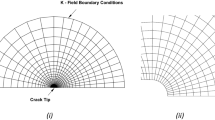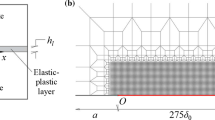Abstract
In the present study, mode I crack subjected to cyclic loading has been investigated for plastically compressible hardening and hardening–softening–hardening solids using the crack tip blunting model where we assume that the crack tip blunts during the maximum load and re-sharpening of the crack tip takes place under minimum load. Plane strain and small scale yielding conditions have been assumed for analysis. The influence of cyclic stress intensity factor range (\(\Delta \hbox {K})\), load ratio (R), number of cycles (N), plastic compressibility (\({\upalpha })\) and material softening on near tip deformation, stress–strain fields were studied. The present numerical calculations show that the crack tip opening displacement (CTOD), convergence of the cyclic trajectories of CTOD to stable self-similar loops, plastic crack growth, plastic zone shape and size, contours of accumulated plastic strain and hydrostatic stress distribution near the crack tip depend significantly on \(\Delta \hbox {K}\), R, N, \({\upalpha }\) and material softening. For both hardening and hardening–softening–hardening materials, yielding occurs during both loading and unloading phases, and resharpening of the crack tip during the unloading phase of the loading cycle is very significant. The similarities are revealed between computed near tip stress–strain variables and the experimental trends of the fatigue crack growth rate. There was no crack closure during unloading for any of the load cycles considered in the present study.


Reproduced with permission from Mohan et al. (2013)
























Similar content being viewed by others
References
Altenbach H, Ochsner A (2014) Plasticity of pressure sensitive materials. Springer, Berlin, pp 173–174
Bouchard PO, Bay F, Chastel Y (2003) Numerical modeling of crack propagation: automatic remeshing and comparision of different criteria. Comput Methods Appl Mech Eng 192:3887–3908
Chang WJ, Kim M, Pan J (1997) Quasi-statically growing crack-tip fields in elastic perfectly plastic pressure-sensitive materials under plane strain conditions. Int J Fract 84:203–228
Ellyin F, Wu J (1992) Elastic–plastic analysis of a stationary crack under cyclic loading and effect of overload. Int J Fract 56:189–208
Fleck NA (1986) Finite element analysis of plasticity-induced crack closure under plane strain conditions. Eng Fract Mech 25:441–449
Gu I, Ritchie RO (1999) On the crack-tip blunting model for fatigue crack propagation in ductile materials. In: Panoutin TL et al (eds) Fatigue and fracture mechanics, vol 29. ASTM STP 1332. West Conshohocken, PA, pp 552–564
Hertzberg RW (1989) Deformation and fracture mechanics of engineering materials. Wiley, New York
Hunnell JM, Kujawski D (2009) Numerical simulation of fatigue crack growth behavior by crack-tip blunting. Eng Fract Mech 76:2056–2064
Hutchens SB, Hall LJ, Greer JR (2010) In situ mechanical testing reveals periodic buckle nucleation and propagation in carbon nanotube bundles. Adv Funct Mater 20:2338–2346
Hutchens SB, Needleman A, Greer JR (2011) Analysis of uniaxial compression of vertically aligned carbon nanotubes. J Mech Phys Solids 59:2227–2237
Hwang KC, Luo XF (1988) Near-tip fields for cracks growing steadily in elastic-perfectly-plastic compressible material. IUTAM symposium on recent advances in nonlinear fracture mechanics, Caltech, Pasadena, CA, USA
Kanninen MF, Popelar CH (1985) Advanced fracture mechanics. Oxford University Press, New York
Khan D, Singh S, Needleman A (2017) Finite deformation analysis of crack tip fields in plastically compressible hardening–softening–hardening solids. Acta Mech Sin 33(1):148–158
Lai J, Van der Giessen E (1997) A numerical study of crack-tip plasticity in glassy polymers. Mech Mater 25:183–197
Laird C, Smith GC (1962) Crack propagation in high stress fatigue. Philos Mag 8:847–857
Levkovitch V, Sievert R, Svendsen B (2005) Simulation of fatigue crack propagation in ductile metals by blunting and re-sharpening. Int J Fract 136:207–220
Li FZ, Pan J (1990) Plane–strain crack-tip fields for pressure-sensitive dilatant materials. J Appl Mech 57:40–49
McClung RC (1991) Crack closure and plastic zone sizes in fatigue. Fatigue Fract Eng Mater Struct 14:455–468
McClung RC, Davidson DL (1991) High resolution numerical and experimental studies of fatigue cracks. Eng Fract Mech 39:113–130
McClung RC, Sehitoglu H (1989) On the finite element analysis of fatigue crack closure.—1. Basic modeling issues.—2. Numerical results. Eng Fract Mech 33:237–272
McClung RC, Thacker BH, Roy S (1991) Finite element visualisation of fatigue crack closure in plane stress and plane strain. Int J Fract 50:27–49
McMeeking RM (1977) Finite deformation analysis of crack tip opening in elastic–plastic materials and implications for fracture. J Mech Phys Solids 25:357–381
Mohan N, Cheng J, Greer JR, Needleman A (2013) Uniaxial tension of a class of compressible solids with plastic non-normality. J Appl Mech 80:040912-1–8
Needleman A, Hutchens SB, Mohan N, Greer JR (2012) Deformation of plastically compressible hardening–softening–hardening solids. Acta Mech Sin 28:1115–1124
Nguyen O, Repetto EA, Ortiz M, Radovitzky RA (2001) A cohesive model of fatigue crack growth. Int J Fract 110:351–369
Peirce D, Shih CF, Needleman A (1984) A tangent modulus method for rate dependent solids. Comput Struct 18(5):875–887
Rice JR (1967) Mechanics of crack tip deformation and extension by fatigue. In: Fatigue crack propagation. ASTM STP 415. American Society for Testing and Materials, pp 247–309
Rudnicki JW, Rice JR (1975) Conditions for the localization of deformation in pressure-sensitive dilatant material. J Mech Phys Solids 23:371–394
Spitzig WA, Richmond O (1979) Effect of hydrostatic pressure on the deformation behavior of polyethylene and polycarbonate in tension and compression. Polym Eng Sci 19(16):1129–1139
Suresh S (1991) Fatigue of materials. Cambridge University Press, Cambridge
Toribio J, Kharin V (2009) Finite deformation analysis of crack tip fields under cyclic loading. Int J Solids Struct 46(9):1937–1952
Toribio J, Kharin V (2004) Hydrogen diffusion near a crack tip after cyclic loading in a strain hardening material, ECF 15, Stockolm
Tvergaard V (2004) On fatigue crack growth in ductile materials by crack-tip blunting. J Mech Phys Solids 52:2149–2166
Tvergaard V, Hutchinson JW (2002) Crack growth per cycle by blunting and void growth. In: Blom AF (Ed) Fatigue 2002, vol.1/5. EMAS, UK, pp 107–116
Wu J, Ellyin F (1996) A study of fatigue crack closure by elastic–plastic finite element analysis for constant amplitude loading. Int J Fract 82:43–65
Yuan H (1994 /1995) Elastoplastic crack analysis for pressure-sensitive dilatant materials. Part II: Interface cracks. Int J Fract 69:167–187
Yuan H, Lin G (1993) Elastoplastic crack analysis for pressure-sensitive dilatant materials. Part I: Higher-order solutions and two-parameter characterization. Int J Fract 61:295–330
Acknowledgements
The authors are most grateful to the reviewers of this paper, particularly for some positive comments and constructive criticism, thereby leading to a more improved presentation.
Author information
Authors and Affiliations
Corresponding author
Additional information
Publisher's Note
Springer Nature remains neutral with regard to jurisdictional claims in published maps and institutional affiliations.
Rights and permissions
About this article
Cite this article
Singh, S., Khan, D. On fatigue crack growth in plastically compressible hardening and hardening–softening–hardening solids using crack-tip blunting. Int J Fract 213, 139–155 (2018). https://doi.org/10.1007/s10704-018-0310-y
Received:
Accepted:
Published:
Issue Date:
DOI: https://doi.org/10.1007/s10704-018-0310-y




